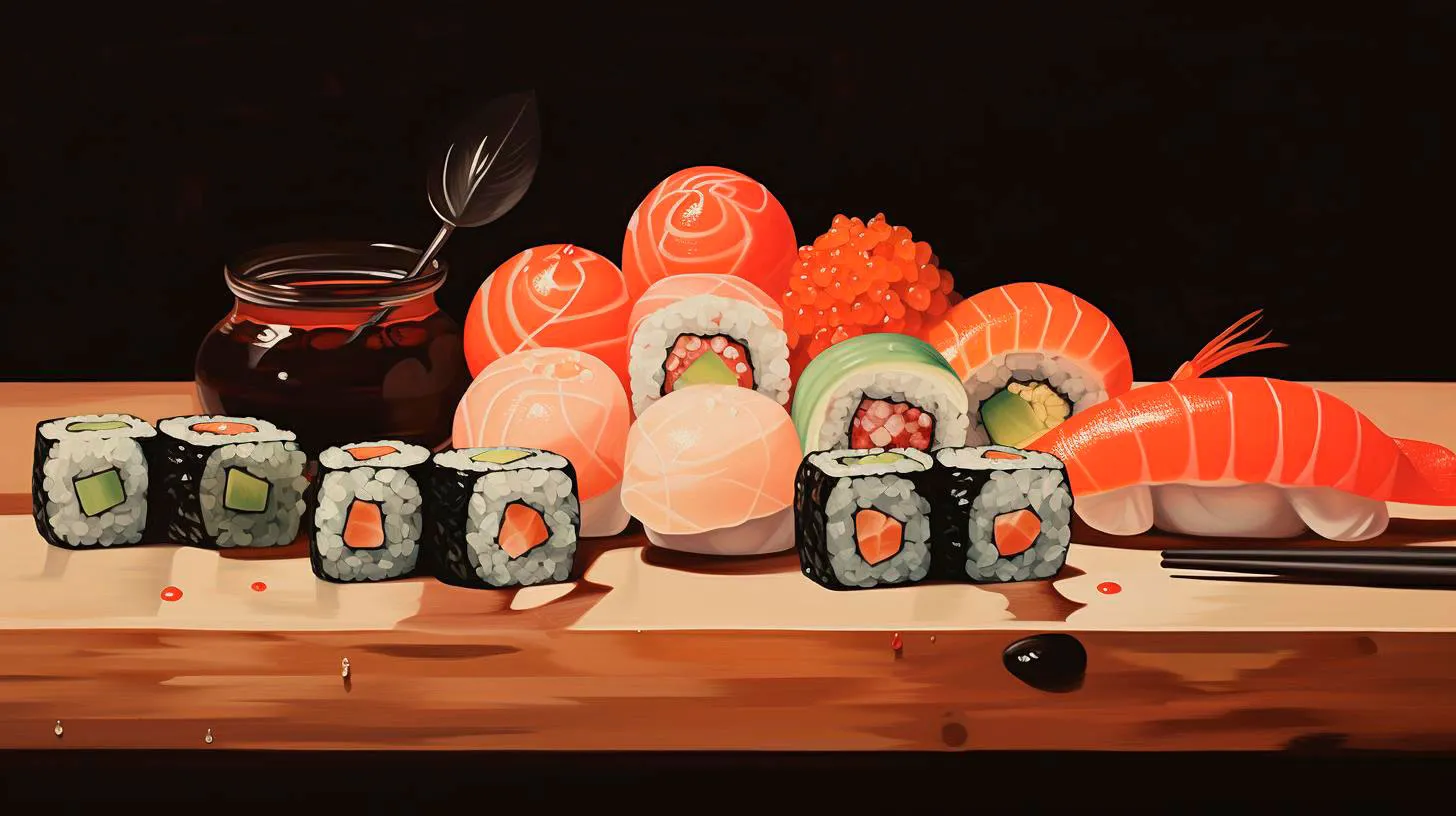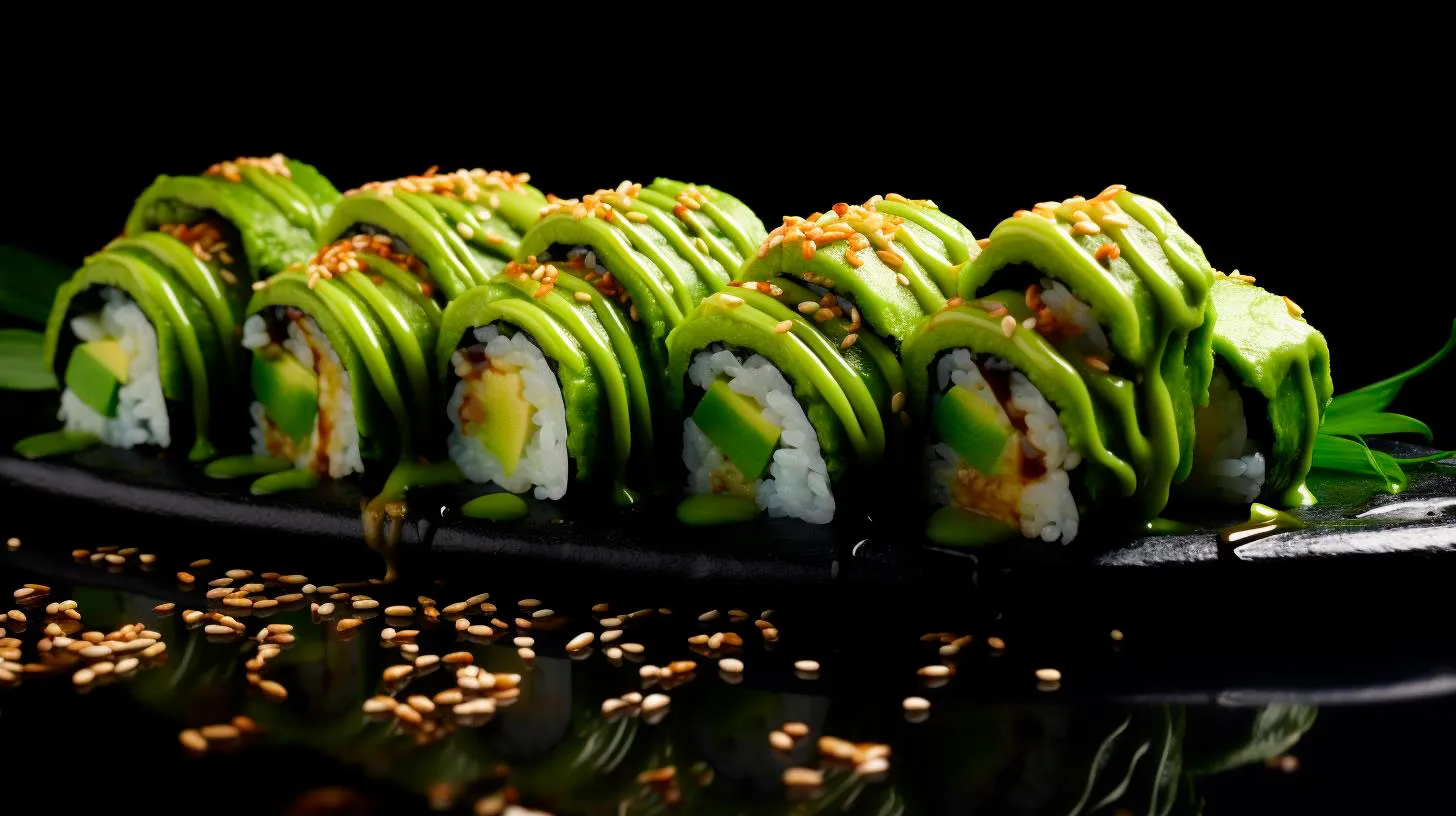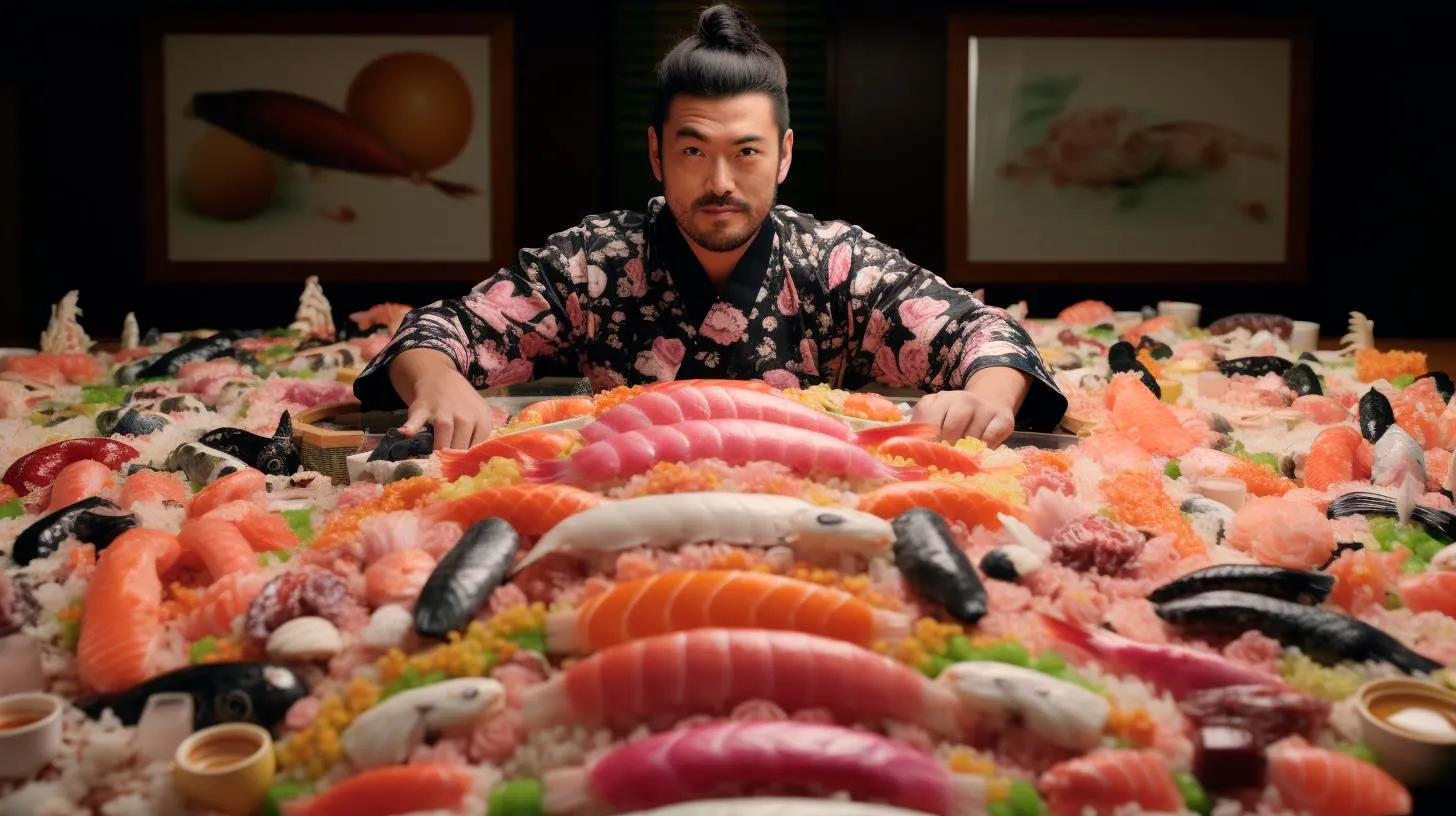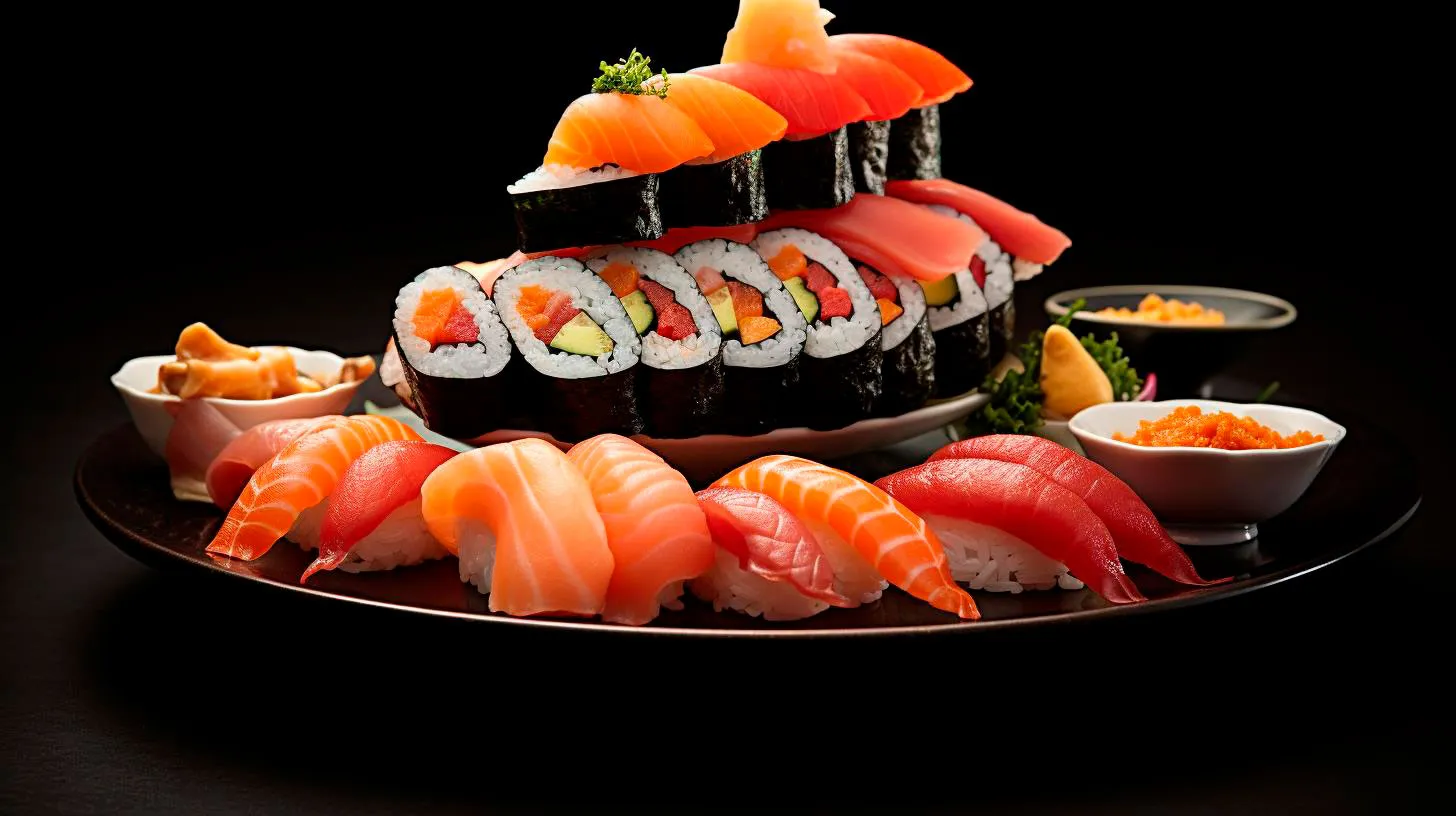Tobiko vs Masago: Unraveling the Secrets of Sushi
In this article, we will unravel the secrets of these delightful fish roes, exploring their differences, benefits, and how they can elevate your sushi experience.
Tobiko: Bursting with Flavor and Color
Tobiko refers to the roe (eggs) of the flying fish and is primarily sourced from the Atlantic Ocean. It is known for its vibrant colors, usually orange or red, although variations such as black, green, and even wasabi-flavored tobiko can be found. The eggs are small, about 0.1 inches (2mm) in diameter, and have a naturally crunchy texture, which adds a delightful pop to your sushi rolls.
Key Takeaways:
- Tobiko is the roe of the flying fish.
- It has vibrant colors, adding visual appeal to sushi.
- Tobiko eggs are small and crunchy, providing a burst of texture.
Tobiko’s flavor is mild, slightly salty, and subtly sweet. It has a delicate oceanic taste that complements the freshness of the sushi. The crunchy texture of tobiko combines well with the smoothness of rice, creating a pleasing contrast in each bite.
When it comes to sushi presentation, tobiko is often used as a topping or garnish due to its appealing colors. It adds a pop of color and a touch of elegance to sushi rolls, making them visually appealing and enticing. Additionally, tobiko can also be mixed into sushi rice or used as a filling in sushi rolls, providing bursts of flavor and texture throughout.
From a nutritional standpoint, tobiko is a good source of omega-3 fatty acids, proteins, and essential vitamins and minerals. Omega-3 fatty acids are known for their heart-healthy benefits, supporting brain function and reducing inflammation.
Masago: A Versatile and Flavorful Option
Masago, on the other hand, is the roe of the capelin fish, which is commonly found in the North Atlantic and Arctic oceans. Unlike tobiko, masago has smaller eggs, about 0.08 inches (2mm) in diameter, and its colors range from bright orange to a paler shade of yellow or light green.
Key Takeaways:
- Masago is the roe of the capelin fish.
- It has smaller eggs compared to tobiko.
- Masago comes in various colors, adding versatility to sushi.
When it comes to taste, masago provides a distinct flavor profile with a hint of saltiness. It has a milder flavor compared to tobiko, making it an excellent choice for those who prefer a subtler taste. Its delicate texture and smaller eggs blend harmoniously with the other ingredients in sushi rolls.
One of the notable features of masago is its versatility. While it is commonly used as a sushi topping, masago can also be used as an ingredient in sushi fillings, sauces, spreads, and even in various non-sushi dishes. Its ability to complement different flavors and textures makes masago a favorite among sushi enthusiasts and chefs.
From a nutritional perspective, masago offers similar health benefits as tobiko. It is rich in omega-3 fatty acids, proteins, and essential nutrients, making it a nutritious addition to your sushi.
The Verdict: Tobiko or Masago?
Choosing between tobiko and masago ultimately depends on your personal preference and the desired culinary experience. However, it’s worth highlighting their distinctive characteristics and recommended uses to make an informed decision.
Tobiko:
- Vibrant colors make it an eye-catching sushi topping or garnish.
- Crunchy texture adds a satisfying “pop” to your sushi rolls.
- Delicate oceanic flavor enhances the freshness of sushi.
Masago:
- Offers versatility in sushi, fillings, sauces, and other dishes.
- Smaller eggs blend well with different flavors and textures.
- Provides a subtle saltiness that complements various ingredients.
Whether you choose the vibrant and crunchy tobiko or the versatile and flavorful masago, incorporating these fish roes into your sushi will undoubtedly elevate your dining experience. The intricate blend of textures and flavors that tobiko and masago bring to sushi rolls is truly a treat for your taste buds.
Next time you order sushi, impress your friends with your knowledge of these hidden gems of the sea. Try different combinations, explore their diverse uses, and savor the explosion of flavors that tobiko and masago bring to your favorite sushi rolls.
From Oceanic Delights to Sushi Masterpieces: The Allure of Tobiko and Masago
In this article, we will delve into the intriguing world of tobiko and masago, exploring their origins, unique characteristics, and why they have become such sought-after delicacies among sushi lovers worldwide.
Tobiko: A Tiny Explosion of Flavor
Originating from Japan, tobiko is the roe of flying fish. These vibrant, bite-sized orbs come in a variety of colors including bright orange, red, green, and even black. The color is not just for visual appeal; it indicates different flavors and seasonings infused into the tobiko. Commonly used as a garnish in sushi, this delicate roe adds a burst of flavor and a delightful textural contrast to every bite. Here are some key highlights of tobiko:
- Flavorful Varieties: Tobiko comes in a range of flavors, from the original natural taste to spicy, wasabi-infused, or even infused with squid ink, creating an explosion of flavor on your palate.
- Eye-catching Appearance: With its vibrant colors, tobiko adds an artistic touch to any sushi roll. It allows sushi chefs to create visually appealing masterpieces that are almost too beautiful to devour.
- Health Benefits: Tobiko is a rich source of Omega-3 fatty acids, which promote heart health and are essential for brain function. It also contains high levels of protein, vitamins, and minerals.
Masago: A Delicate Delight
Like tobiko, masago is also a type of fish roe commonly found in Japanese cuisine. However, while tobiko comes from flying fish, masago hails from the smaller capelin fish. Its tiny, crunchy eggs offer a distinct flavor that compliments various sushi creations. Here’s what makes masago a unique ingredient:
- Subtle Flavor Burst: Masago delivers a milder, slightly saltier taste compared to tobiko. Its small, crunchy texture adds a delightful pop to every bite, enhancing the overall sushi experience.
- Colorful Appeal: Masago eggs are typically bright orange, providing a beautiful visual contrast when used as a garnish. The vibrant hue catches the eye and elevates the presentation of any sushi dish.
- Healthy Goodness: Similar to tobiko, masago is packed with Omega-3 fatty acids, boosting heart health while providing essential nutrients such as vitamin D, selenium, and iron.
The Allure of Tobiko and Masago in Sushi Rolls
If you’re a sushi aficionado, you’ve likely encountered both tobiko and masago as key components in various sushi rolls. Here are a few reasons why they have become indispensable ingredients in sushi creation:
- Enhanced Flavor Profile: Tobiko and masago contribute a burst of flavor to sushi rolls, elevating the taste profile of each bite.
- Textural Play: The crunchy texture of these fish roe creates a delightful contrast when combined with the softness of rice and the creaminess of other ingredients.
- Visual Appeal: Their vibrant colors make sushi rolls visually striking and exceptionally appealing, appealing to both the eyes and the taste buds.
- Creative Potential: Sushi chefs can let their creativity shine by using tobiko and masago to add unexpected flavors and visual elements to their rolls, offering unique and exciting combinations for their patrons.
Key Takeaways
Tobiko and masago, two tiny but mighty ingredients, have made their mark in the world of sushi. Whether you’re looking to add a burst of flavor, a pop of color, or a delightful textural element, these fish roe deliver on all fronts. Here are the key takeaways:
- Tobiko and masago are fish roe delicacies that enhance the taste, texture, and aesthetics of sushi rolls.
- They come in various flavors and colors, allowing for versatile and creative sushi creations.
- Both tobiko and masago are rich sources of Omega-3 fatty acids and other essential nutrients.
- These ingredients add depth and complexity to the overall sushi experience, delighting both sushi connoisseurs and newcomers alike.
So, the next time you indulge in a sushi feast, pay attention to these intricate yet irresistible ingredients. Let the enchanting allure of tobiko and masago transport you to a world of oceanic delights and sushi masterpieces!
Exploring Tobiko Sushi: Tiny Orange Gems
In this article, we will explore the world of Tobiko Sushi, its origins, taste profile, health benefits, and how you can incorporate it into your sushi experience.
What is Tobiko Sushi?
Tobiko is a type of flying fish roe commonly used in Japanese cuisine, particularly in sushi. The word “Tobiko” translates to “flying fish roe” in English. These small, crunchy, orange-colored eggs are harvested from the flying fish species found predominantly in the Pacific Ocean. With its captivating hue and unique texture, Tobiko is often used as a sushi topping or as a key ingredient in sushi rolls.
Taste Profile and Textural Delight
When you place a piece of Tobiko Sushi in your mouth, you are greeted with a delightful burst of flavor. The taste is often described as mildly salty with a hint of sweetness. The crunchy pop when the eggs burst in your mouth adds an interesting textural element to the sushi. This combination of flavor and texture elevates the sushi experience to a whole new level.
It is important to note that Tobiko is available in a variety of flavors, such as wasabi, yuzu, squid ink, truffle, and spicy. Each flavor brings its unique twist to the traditional Tobiko, allowing you to explore different taste profiles and find your personal favorite.
Health Benefits of Tobiko Sushi
Tobiko Sushi not only pleases your taste buds but also offers various health benefits. Here are some key advantages of including Tobiko in your sushi repertoire:
- Rich in Omega-3 Fatty Acids: Tobiko is an excellent source of omega-3 fatty acids, which are essential for brain function, heart health, and reducing inflammation in the body. Including Tobiko in your diet can help fulfill your omega-3 requirements.
- Protein-Rich: The roe is packed with high-quality protein, making Tobiko a great option for those looking to increase their protein intake without consuming meat or poultry.
- Low in Calories: Compared to other sushi toppings like mayonnaise or tempura, Tobiko is relatively low in calories, making it a healthier choice for sushi enthusiasts who are conscious of their calorie intake.
- Rich in Nutrients: Tobiko contains essential vitamins, such as vitamin E, B12, and folate, along with minerals like calcium and iron. These nutrients contribute to overall health and well-being.
Incorporating Tobiko into Your Sushi Experience
If you are eager to try Tobiko Sushi and want to explore its versatility, here are some exciting ways to incorporate it into your sushi experience:
- Tobiko Nigiri: Enjoy Tobiko as a topping for your classic nigiri sushi. The vibrant colors and pop of texture will surely impress both visually and gastronomically.
- Tobiko Sushi Rolls: Add a layer of Tobiko inside your sushi rolls to introduce a delightful crunch and an explosion of flavor with every bite.
- Tobiko Sashimi: For a simpler approach, enjoy Tobiko as a garnish on fresh sashimi slices. The contrast of the orange roe against the fish will enhance both the visual appeal and taste.
- Tobiko Poke Bowls: Sprinkle Tobiko generously on top of your poke bowl to add a burst of color, flavor, and texture to this popular Hawaiian dish.
By incorporating Tobiko into your sushi experience, you can add a unique twist to your favorite dishes and surprise your taste buds. The possibilities are endless with this tiny orange gem!
Conclusion
Tobiko Sushi, with its vibrant color, burst of flavor, and textural delight, is a sushi variety worth exploring. From its origins in flying fish roe to the diverse flavor options available, Tobiko offers a sensory experience that can elevate your sushi enjoyment. Furthermore, the health benefits provided by the omega-3 fatty acids, protein, and essential nutrients make it an excellent addition to a well-balanced diet. So, next time you visit a sushi restaurant or decide to make sushi at home, don’t forget to give Tobiko Sushi a try. Your taste buds will thank you!
Masago: The Unsung Hero of Sushi Rolls
In this article, we will explore the unique qualities of masago and why it deserves recognition as the unsung hero of sushi rolls.
What is Masago?
Masago is a type of fish roe commonly used in sushi and Japanese cuisine. It is made from the eggs of capelin, a small marine fish found in the cold waters of the North Atlantic and North Pacific oceans. The roe is processed, salted, and then used as a topping or ingredient in various dishes, particularly sushi rolls.
Unlike other types of fish roe, such as ikura (salmon roe) or tobiko (flying fish roe), masago has smaller eggs and a delicate, crunchy texture. The eggs are typically orange in color, but they can also be dyed to create vibrant shades of red, green, or black for aesthetic purposes.
The Flavorful Benefits of Masago
While masago may be small in size, it is big on flavor. Here are some reasons why masago deserves more attention:
- Umami Explosion: Masago has a naturally salty and savory taste, adding a delightful umami flavor to sushi rolls. It enhances the overall taste profile and brings out the flavors of other ingredients.
- Textural Delight: The tiny eggs of masago provide a satisfying crunch in every bite. This unique texture offers a pleasant contrast to the softness of rice and creaminess of other ingredients in sushi rolls.
- Nutritional Value: Masago is not only delicious but also packed with nutrition. It is a rich source of Omega-3 fatty acids, which are beneficial for heart health and brain function.
Ways to Enjoy Masago
While masago is commonly used as a topping for sushi rolls, its versatility allows it to shine in various dishes. Here are a few delicious ways to enjoy masago:
- Sushi Rolls: Masago adds color, flavor, and texture to sushi rolls. Popular rolls such as California rolls, spicy tuna rolls, and dragon rolls often feature masago as a key ingredient.
- Poke Bowls: Create a vibrant and flavorful poke bowl by adding masago as a topping. Its crunchiness and burst of umami take the bowl to a whole new level.
- Sushi Nigiri: Instead of using traditional soy sauce, try dipping your sushi nigiri in masago. The roe will add an extra layer of flavor to each bite.
- Sushi Garnish: Use masago as a garnish to elevate the presentation of your sushi platter. Sprinkle it over rolls, sashimi, or even salads for a pop of color and taste.
Key Takeaways
Masago may be an unsung hero, but its unique qualities and flavorful benefits make it a valuable addition to sushi rolls. Remember these key takeaways:
- Masago is a type of fish roe made from capelin eggs.
- It has a crunchy texture, a burst of umami flavor, and is rich in Omega-3 fatty acids.
- Use masago as a topping in sushi rolls, poke bowls, or as a garnish to enhance the overall taste and presentation of dishes.
Next time you indulge in sushi, don’t forget to appreciate the unsung hero – masago. Its vibrant color, unique texture, and delicious flavor make it an outstanding ingredient that deserves a moment in the spotlight.



